
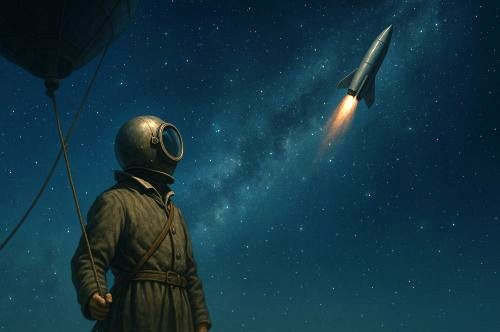
The dream of spaceflight, cultivated in imagination, theory, and experiment, gave rise to the technology that made Sputnik possible. To reach orbit, humanity first had to learn how to almost reach it.

By Matthew A. McIntosh
Public Historian
Brewminate
Introduction
On October 4, 1957, Sputnik 1 pierced the skies above Kazakhstan and entered orbit, circling the Earth in ninety-six minutes. This moment has often been described as the beginning of the Space Age. Yet the path to Sputnik stretched across centuries of human imagination, decades of scientific inquiry, and many hard-fought experiments that fell short of orbit but nonetheless reached toward the heavens.
The story of “pre-space” spaceflight is one of persistence. From the speculative mathematics of a Russian schoolteacher, to the lonely experiments of a New England physicist, to the terrifying military rockets of Nazi Germany, humans repeatedly inched closer to leaving Earth. None of these attempts succeeded in achieving orbit before 1957, but each effort (whether theoretical, experimental, or destructive) built a foundation that made Sputnik possible. To appreciate the breakthrough, we must examine the intellectual and technical steps that came before: the dreams, the experiments, and the failures that together created the first real possibility of space travel.
Early Theoretical Foundations
Konstantin Tsiolkovsky and the Mathematics of Escape
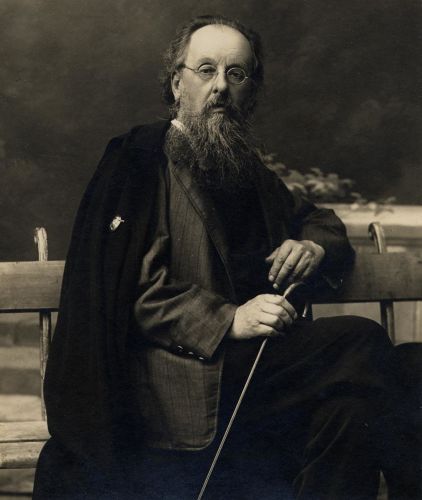
Konstantin Tsiolkovsky, a provincial schoolteacher living in the small Russian town of Kaluga, became the unlikely father of astronautics. In the 1890s he published a series of essays on the mechanics of flight. While many of his contemporaries focused on airships or heavier-than-air craft, Tsiolkovsky turned his gaze outward. By 1903, in his famous paper Exploration of Cosmic Space by Means of Reaction Devices, he had formulated the “rocket equation,” demonstrating mathematically that rockets could escape Earth’s gravity.1
Tsiolkovsky’s insight was twofold. First, he recognized that rockets, unlike airplanes, did not require air to push against; they worked equally well in a vacuum. This simple but profound recognition set him apart from much of the engineering community, which still dismissed rocketry as a crude technology suited only to fireworks.2 Second, he emphasized the necessity of liquid propellants and multistage designs. Solid fuels burned too inefficiently; only by stacking stages and discarding empty tanks could a rocket gain the velocity required to reach orbit.3
Though Tsiolkovsky lacked the resources to construct rockets himself, his writings circulated widely in Russian scientific circles. Later generations, including Sergei Korolev and other Soviet engineers, revered him as a prophet of spaceflight. His equations would eventually govern the trajectories of real rockets, but in the early 20th century they were a speculative dream: precise, elegant, and far ahead of the available technology.
The Imaginative Continuum
Scientific equations did not exist in a cultural vacuum. The public imagination of the nineteenth century was already primed for the notion of space travel. Jules Verne’s From the Earth to the Moon (1865) envisioned a massive cannon in Florida launching a capsule of daring adventurers.4 Though absurdly impractical (the g-forces would have crushed any human instantly) Verne’s novel thrilled readers, embedding the very idea of leaving Earth in popular culture.
Other writers followed suit. Edward Everett Hale’s The Brick Moon (1869) described an artificial satellite orbiting Earth, a strikingly prescient vision of orbital mechanics decades before they became reality.5 Such imaginative works did not offer technical solutions, but they cultivated a climate of curiosity. By the time Tsiolkovsky and later engineers began publishing serious proposals, the idea of humans venturing beyond the atmosphere was no longer unthinkable. Science fiction prepared the ground for science itself.
Early Rocket Experiments (1900s–1930s)
The American Pioneer: Robert Goddard
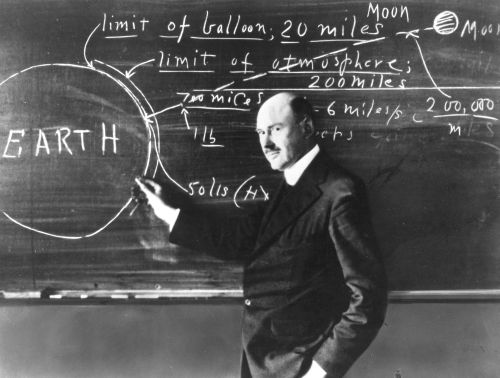
While Tsiolkovsky offered equations, Robert Goddard pursued hardware. A physics professor from Worcester, Massachusetts, Goddard believed that rockets could ascend far higher than conventional aircraft. In 1919, he published A Method of Reaching Extreme Altitudes, laying out the basic physics of spaceflight.6 His claims, including the possibility of a rocket reaching the Moon, drew public ridicule. The New York Times dismissed him with a scathing editorial that insisted rockets could not function in a vacuum.7
Undeterred, Goddard conducted experiments in relative obscurity. On March 16, 1926, he launched the world’s first liquid-fueled rocket from a snowy farm in Auburn, Massachusetts. The small craft sputtered and flew for just 2.5 seconds, reaching 41 feet in altitude, but it proved the principle.8 Over the following decade, working with limited funds in New Mexico, Goddard built increasingly sophisticated rockets. He developed gyroscopic stabilization, steering vanes, and concepts for multistage vehicles. Some of his launches reached altitudes of over two kilometers.
Though Goddard’s results were impressive, his work remained underappreciated in the United States, where military and government support was minimal. Ironically, his patents and publications later guided both German and American engineers during and after World War II. Goddard did not send anything close to space, but his innovations turned rocketry into a legitimate scientific field rather than a fanciful toy.
Soviet Experiments: The GIRD Group
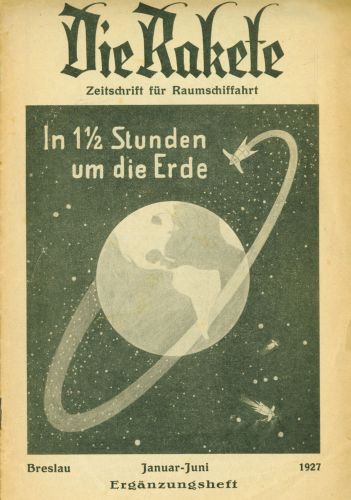
Across the Atlantic, the Soviet Union nurtured its own cadre of rocketry enthusiasts. In 1931, the Group for the Study of Reactive Motion (Gruppa Izucheniya Reaktivnogo Dvizheniya, or GIRD) formed in Moscow. Comprised of young engineers and visionaries such as Sergei Korolev and Friedrich Zander, GIRD became a hub of experimentation. In 1933, the group successfully launched the GIRD-09, a liquid-fueled rocket that demonstrated stable flight.9
The Soviet government soon recognized the potential of such work, absorbing GIRD into the newly created Reactive Scientific Research Institute (RNII). But the Stalinist purges of the late 1930s disrupted progress. Zander died of illness, and Korolev was imprisoned in a labor camp for several years. Yet the seed had been planted. When Korolev was released during World War II, he carried with him both technical knowledge and a passion for space that would later make him the chief designer of Sputnik.
Germany and the Rocket Enthusiasts
In Germany, the post–World War I restrictions of the Versailles Treaty, which banned long-range artillery, ironically encouraged interest in rockets. Civilian enthusiasts gathered in the 1920s to form the Verein für Raumschiffahrt (Society for Space Travel), testing liquid-fuel rockets on the outskirts of Berlin.10 Among the participants was a young Wernher von Braun, who would later play a pivotal role in both the Nazi rocket program and the American Apollo missions.
By 1932, the German Army had taken an interest in rocketry as a potential weapon. Under military patronage, research shifted from small-scale experiments to large-scale development. At the Peenemünde research facility, engineers refined liquid-fuel technology into the V-2 ballistic missile. What had begun as a hobbyist movement transformed into one of the most advanced military research programs of the 20th century.
The V-2 and the Edge of Space
The V-2 (Aggregat-4) was both a weapon of terror and a technical marvel. First successfully launched in 1942, it became the world’s first long-range guided ballistic missile. Its supersonic speed and liquid-fuel propulsion represented a radical leap beyond anything attempted before. Test flights achieved altitudes of nearly 190 kilometers, high enough to pass the Kármán line, the conventional boundary of space.11
Yet the V-2 was not an orbital vehicle. Its trajectories were ballistic arcs, carrying warheads toward London and Antwerp in devastating raids. Over 3,000 were launched during the war, killing thousands of civilians.12 The rocket demonstrated the raw capability to reach space, but in service of destruction rather than exploration.
Nonetheless, the V-2 marked a turning point. For the first time, a human-made object touched the realm of space, however briefly. After the war, both the United States and the Soviet Union raced to capture German technology and expertise, recognizing that rockets had applications far beyond military bombardment.
Postwar Developments (1945–1957)
United States: White Sands and the Bumper-WAC
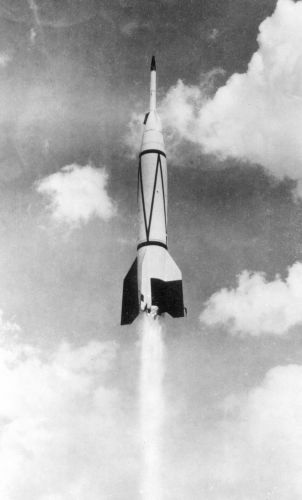
In the immediate aftermath of World War II, American forces transported hundreds of V-2 rockets and dozens of German engineers, including von Braun, to the United States. At White Sands Proving Ground in New Mexico, these captured weapons became test vehicles for both military and scientific purposes.
Between 1946 and 1952, dozens of V-2 launches carried instruments to measure cosmic rays, solar radiation, and atmospheric composition. Some flights even included cameras that returned the first photographs of Earth from space, taken at altitudes above 100 kilometers.13 These experiments revealed a new possibility: rockets could be not only weapons but also tools of science.
The most ambitious postwar test came in 1950 with the Bumper-WAC project. Engineers mounted a small WAC Corporal rocket atop a V-2 booster. After the V-2 carried the vehicle to high altitude, the upper stage fired, propelling the WAC Corporal to nearly 400 kilometers, higher than the orbit of the International Space Station today.14 Though suborbital, this flight represented humanity’s deepest penetration into space prior to Sputnik.
Soviet Union: From V-2 to R-7
The Soviet Union also seized V-2 technology, though they lacked the same access to German engineers as the Americans. Instead, they relied on their own expertise, building upon the interrupted work of Korolev and his colleagues. By the late 1940s, Soviet engineers had produced their own intermediate-range rockets, gradually scaling up their size and power.
Korolev, rehabilitated and placed in charge of the Soviet program, envisioned more than weapons. He dreamed of launching satellites and eventually humans. His R-7 Semyorka, completed in the mid-1950s, was designed as an intercontinental ballistic missile but possessed more thrust than any previous rocket.15 In 1957, this vehicle carried Sputnik 1 into orbit, achieving the dream that Tsiolkovsky had first calculated half a century earlier.
Conclusion
Before humanity truly entered orbit, it reached for space in countless ways: through equations and fiction, through hobbyist experiments and military monstrosities, through scientific salvage of captured technology, and through the ambitions of engineers who saw rockets as more than weapons. Tsiolkovsky wrote the mathematics; Goddard proved the mechanics; Korolev and von Braun endured political storms to push the field forward. The V-2 soared high enough to touch the edge of space, but it was still a weapon. The Bumper-WAC reached astonishing altitudes, but it fell back to Earth.
Only in 1957 did a payload finally stay aloft, circling the Earth again and again. Yet every step before mattered. The dream of spaceflight, cultivated in imagination, theory, and experiment, gave rise to the technology that made Sputnik possible. To reach orbit, humanity first had to learn how to almost reach it.
Appendix
Footnotes
- Konstantin Tsiolkovsky, “Exploration of Cosmic Space by Means of Reaction Devices” (1903), trans. NASA Technical Translation (Washington, DC: NASA, 1965), 1–3.
- James Andrews, Red Cosmos: K. E. Tsiolkovskii, Grandfather of Soviet Rocketry (College Station: Texas A&M University Press, 2009), 41–44.
- Ibid., 45–47.
- Jules Verne, From the Earth to the Moon (Paris: Hetzel, 1865).
- Edward Everett Hale, The Brick Moon (Boston: Fields, Osgood, & Co., 1869).
- Robert Goddard, “A Method of Reaching Extreme Altitudes” (Smithsonian Institution Miscellaneous Collections, 1919).
- “A Severe Strain on Credulity,” The New York Times, January 13, 1920.
- Milton Lehman, This High Man: The Life of Robert H. Goddard (New York: Farrar, Straus & Giroux, 1963), 156–58.
- Asif Siddiqi, The Red Rockets’ Glare: Spaceflight and the Soviet Imagination, 1857–1957 (Cambridge: Cambridge University Press, 2014), 121–23.
- Michael J. Neufeld, The Rocket and the Reich: Peenemünde and the Coming of the Ballistic Missile Era (New York: Free Press, 1995), 32–35.
- Walter Dornberger, V-2 (New York: Viking, 1954), 189–93.
- Neufeld, The Rocket and the Reich, 221–26.
- Loyd S. Swenson Jr., James M. Grimwood, and Charles C. Alexander, This New Ocean: A History of Project Mercury (Washington, DC: NASA, 1966), 25–28.
- Erik M. Conway, High-Speed Dreams: NASA and the Technopolitics of Supersonic Transportation (Baltimore: Johns Hopkins University Press, 2005), 14–16.
- Siddiqi, The Red Rockets’ Glare, 237–40.
Bibliography
- Andrews, James. Red Cosmos: K. E. Tsiolkovskii, Grandfather of Soviet Rocketry. College Station: Texas A&M University Press, 2009.
- Conway, Erik M. High-Speed Dreams: NASA and the Technopolitics of Supersonic Transportation. Baltimore: Johns Hopkins University Press, 2005.
- Dornberger, Walter. V-2. New York: Viking, 1954.
- Goddard, Robert. “A Method of Reaching Extreme Altitudes.” Smithsonian Institution Miscellaneous Collections, 1919.
- Hale, Edward Everett. The Brick Moon. Boston: Fields, Osgood, & Co., 1869.
- Lehman, Milton. This High Man: The Life of Robert H. Goddard. New York: Farrar, Straus & Giroux, 1963.
- Neufeld, Michael J. The Rocket and the Reich: Peenemünde and the Coming of the Ballistic Missile Era. New York: Free Press, 1995.
- Siddiqi, Asif. The Red Rockets’ Glare: Spaceflight and the Soviet Imagination, 1857–1957. Cambridge: Cambridge University Press, 2014.
- Swenson, Loyd S. Jr., James M. Grimwood, and Charles C. Alexander. This New Ocean: A History of Project Mercury. Washington, DC: NASA, 1966.
- Tsiolkovsky, Konstantin. “Exploration of Cosmic Space by Means of Reaction Devices.” Translated in NASA Technical Translation, 1965.
- Verne, Jules. From the Earth to the Moon. Paris: Hetzel, 1865.
- The New York Times. “A Severe Strain on Credulity.” January 13, 1920.
Originally published by Brewminate, 09.09.2025, under the terms of a Creative Commons Attribution-NonCommercial-NoDerivatives 4.0 International license.


